Introduction to Lubo Kristek’s Happenings and Performances
“Art is nothing abstract, theoretical. We cannot detach it or set it apart. Art must live, and I want to be the intermediary of life.” (1)
In 1968, after the allied armies invaded the then Czechoslovakia, Lubo Kristek left to go to the free world. His last work in his homeland was a fist raised against the occupation on protest posters. But in the “free world” there was already at that time a highly developed business in art (with only a slight overstatement, one might say that every artist had a price assigned per square or cubic centimetre of his work), which was in stark contrast to the motivations that had lead Kristek to his work. He had no intention of conforming to the institutionalised and commercial concept of art which binds the artist and dictates to him.
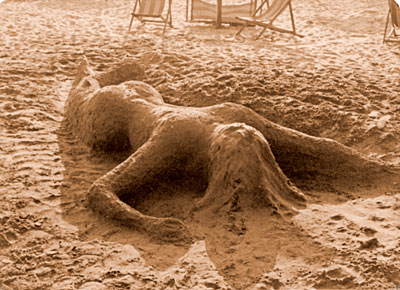 So he created his own parallel world in which he could feel, create and live, and which would fulfil him. On frequent trips to unknown lands (Italy, Spain, USA, Canada etc.), he was fascinated by the magical moment when a work was created from the material which fate put in his way or which washed up from the sea. But it was not an isolated world. All those who wanted to share Kristek’s world were invited to it. When on the Italian coastline near Pesaro he made a mermaid out of sand just for a brief and ephemeral moment of existence, a group of people gradually grew around him and together watched and recorded how the sea swallowed up the work with each wave (Kristek named the work of art Mermaid Raped by the Beach Public). Then they spent a long time discussing the natural cycle of creation and destruction.
So he created his own parallel world in which he could feel, create and live, and which would fulfil him. On frequent trips to unknown lands (Italy, Spain, USA, Canada etc.), he was fascinated by the magical moment when a work was created from the material which fate put in his way or which washed up from the sea. But it was not an isolated world. All those who wanted to share Kristek’s world were invited to it. When on the Italian coastline near Pesaro he made a mermaid out of sand just for a brief and ephemeral moment of existence, a group of people gradually grew around him and together watched and recorded how the sea swallowed up the work with each wave (Kristek named the work of art Mermaid Raped by the Beach Public). Then they spent a long time discussing the natural cycle of creation and destruction.
Kristek set off on his journeys from a studio (it was an old skittle hall) in the German town of Landsberg am Lech. His creative environment is described by the head of the cultural section of Radio Free Europe, Jaroslav Dresler (1925–1999):
“…a painter’s studio, smaller part of a skittle hall. We don’t walk into it, but we crawl on all fours and on our stomachs. When we get inside, we see that we have crawled through an old cupboard which is part of a spatial partition. Here it is like in a fairy-tale world, with chests and secret storage pockets, but there is prosaic kitchenware, a stove, bed and portable television here too. Kristek often works into the night here. (…) Kristek works in large, simplified shapes and volumes. He rejects the traditional and modern aesthetic, and if we understand him properly, he’s really interested in the dematerialisation of sculpture, the spiritual expression below the surface of things and shapes. (…) In his serious, sensitive and intellectually charged work there are many traits of this future solidity and generosity of the immediate and simple form.” (2)
At that time, Kristek was thirty-two years old.
Video: Lubo Kristek’s studio in 1974
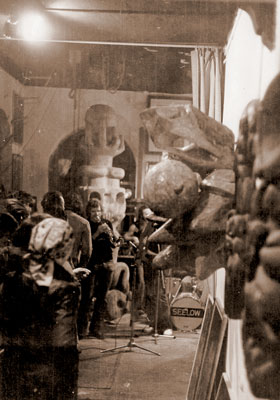
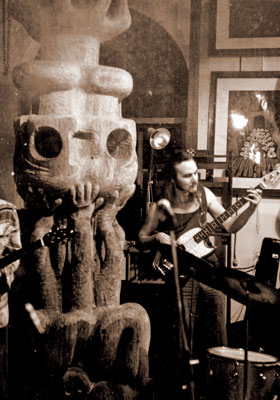 And this was the place where, in 1971, the tradition of Kristek’s Night Vernissages came into being. He became an active organiser of artists’ meetings and exhibitions which always lasted only one night. He selected this length of time intentionally. The visitor had to decide whether he was coming today… or never. In this way, Kristek wanted to force the spectators to admit their priorities. He felt a need to act “here and now”. He didn’t wait, didn’t plan things out, and he acted. He realised the ephemeral nature of the moment, and so he tried to fulfil each one of them to the maximum. The motto of one of the night vernissages in 1975(3) was: “… in order to better understand the struggle between ephemerality and immortality on earth...”
And this was the place where, in 1971, the tradition of Kristek’s Night Vernissages came into being. He became an active organiser of artists’ meetings and exhibitions which always lasted only one night. He selected this length of time intentionally. The visitor had to decide whether he was coming today… or never. In this way, Kristek wanted to force the spectators to admit their priorities. He felt a need to act “here and now”. He didn’t wait, didn’t plan things out, and he acted. He realised the ephemeral nature of the moment, and so he tried to fulfil each one of them to the maximum. The motto of one of the night vernissages in 1975(3) was: “… in order to better understand the struggle between ephemerality and immortality on earth...”
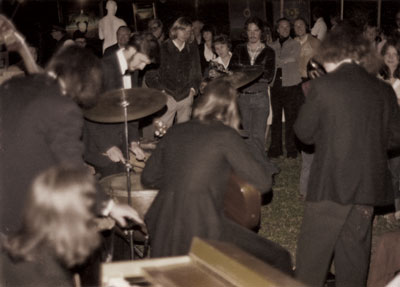 In 1976, the German magazine Collage carried an interview with the German sculptor and performer Joseph Beuys (1921–1986) about his projects in the 1960s and 1970s. In the same edition, the magazine mapped out Lubo Kristek’s work and especially the first years of Kristek’s Night Vernissages:
In 1976, the German magazine Collage carried an interview with the German sculptor and performer Joseph Beuys (1921–1986) about his projects in the 1960s and 1970s. In the same edition, the magazine mapped out Lubo Kristek’s work and especially the first years of Kristek’s Night Vernissages:
“It is now five years since Lubo Kristek organised his first night vernissage with no financial support. And the fourth one will be held this year. At them artists from every corner of Germany, Canada, England and the USA meet and exhibit, celebrate and discuss, and they shake the ideologies of garden gnomes to their foundations.” (4)
 The events were held without an entry fee as a meeting of painters, sculptors, poets, philosophers, musicians and also regular visitors. From the very beginning, the linkage of various muses was quite common for Kristek. At the vernissages, there were readings by authors, for example the German writer, philosopher and artist Boerries-Peter Kopton (born 1942), or jazz concerts by the bands associated with the double bass player Litschie Hrdlicka (born 1955), who represented a link to the contemporary musical world for Kristek. At the night vernissage in 1974, there was a performance by the group Passport, of the famous German saxophonist and film music composer Klaus Doldinger (born 1936). The preserved catalogue from the night vernissage in 1976(5), which included 98 works of sculpture and painting, provides evidence of the scope of the exhibitions that were held in Kristek’s studio (and also neighbouring garden).
The events were held without an entry fee as a meeting of painters, sculptors, poets, philosophers, musicians and also regular visitors. From the very beginning, the linkage of various muses was quite common for Kristek. At the vernissages, there were readings by authors, for example the German writer, philosopher and artist Boerries-Peter Kopton (born 1942), or jazz concerts by the bands associated with the double bass player Litschie Hrdlicka (born 1955), who represented a link to the contemporary musical world for Kristek. At the night vernissage in 1974, there was a performance by the group Passport, of the famous German saxophonist and film music composer Klaus Doldinger (born 1936). The preserved catalogue from the night vernissage in 1976(5), which included 98 works of sculpture and painting, provides evidence of the scope of the exhibitions that were held in Kristek’s studio (and also neighbouring garden).
Video: Kristek’s Night Vernissage (1970s)
Kristek’s Night Vernissages were decisive for his artistic development. At these events, he formulated his opinions. This environment became the substrate for his happenings.
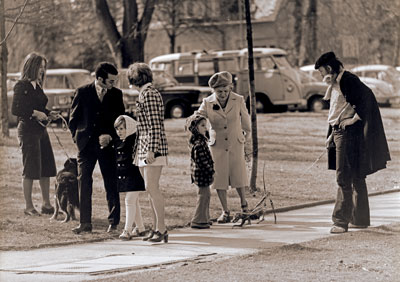 It is true to say that he has been accompanied by happening-like events since childhood. As a boy, he arranged live grass snakes in his grandmother’s hat as she sat unsuspectingly on a bench in a spa park. Later his entire life became infused with happenings, and he even often blends in with them, such as during his experiments at the interface between theatre, music and improvisation that took place in the 1960 in a former soap factory in Hustopeče or in 1975, when he put a lead on a fox's skeleton still bearing the remnants of dried skin (which he found frozen in the woods) and took it for a walk on the famous Landsberg colonnade along the river Lech and observed with interest the reactions of the people (he called the action Promenade with a Neurotic Fox and let it photo-documented).
It is true to say that he has been accompanied by happening-like events since childhood. As a boy, he arranged live grass snakes in his grandmother’s hat as she sat unsuspectingly on a bench in a spa park. Later his entire life became infused with happenings, and he even often blends in with them, such as during his experiments at the interface between theatre, music and improvisation that took place in the 1960 in a former soap factory in Hustopeče or in 1975, when he put a lead on a fox's skeleton still bearing the remnants of dried skin (which he found frozen in the woods) and took it for a walk on the famous Landsberg colonnade along the river Lech and observed with interest the reactions of the people (he called the action Promenade with a Neurotic Fox and let it photo-documented).
Kristek’s Night Vernissages became the catalyst for his creativity, and this inspirational environment was a forerunner of the future voluminous happenings with many participants, often evocative of the Baroque concept of theatre (by putting together many components to create a coherent piece).
According to archived film from the early 1970s, both artists and visitors participated in his happenings. These were experiments at the interface between music, theatre and ritual. They consisted of improvisation, symbols of reciprocity (for example, foot washing), pilgrimage (for example, the midnight journey to the cemetery) or social inclusion (joining in with the dance in an abandoned chapel). Kristek emphasises the immediate experiencing of the moment.
Video: one of the first Kristek’s happenings at his night vernissage in the early 1970s
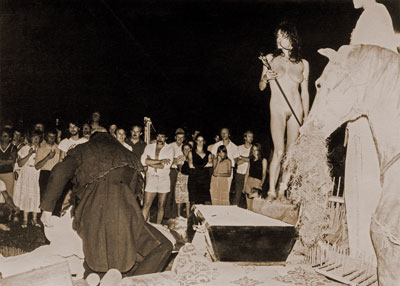
The happenings gradually become an independent part of his work. The lifecycle, birth, death and rebirth, the intergrowth of forms, liberation from shackles and stereotypes all constitute an integral part of it. An article from the time explains the atmosphere of the happening Rebirth of Kristek’s Fantasy in 1983:
“Darkness, music full of tension. All of a sudden a carriage emerges from the dark, it stops, and men in black unload a coffin from the carriage. The sweeping searchlight illuminates a naked woman who stands rooted to the spot watching this scene. The corpse from the coffin is freed from its mummy's shroud, and the naked woman brings him back to life with a wand. His first act after rebirth: he dresses her and goes off with her into the light.” (6)
Kristek’s events could be classified as happenings, performances or sometimes even site specific, but he himself choses the original expression "happening", because for him the involvement of the public and an authentic experience are crucial. He intentionally breaks down the boundary between the spectator and the performer, between the passive recipient and the participant. Sometimes he is part of the procession, such as in the happening The Burial of the Seven-Sin Heritage or Where Evrum is Born(7), sometimes the participants and spectators cover themselves in paint, as in the happening A Cart Full of Tones(8) (this motif also appeared in the 5th happening upon the opening of Kristek Thaya Glyptotheque). In some events Kristek wholly dissolved the boundary between the stage and the auditorium. In the happening Visio Sequentes or Concerning the Prematurely Cloned Age of One Planet (9), he worked with mentally disabled people who in the concluding gradation dispersed amongst the spectators. There was significant shock, and the spectators started to look around uncomfortably to find out “who’s who?” or “who's really the madman here?”
Video: happening Visio Sequentes
or Concerning the Prematurely Cloned Age of One Planet
(4th July 2003, Znojmo)
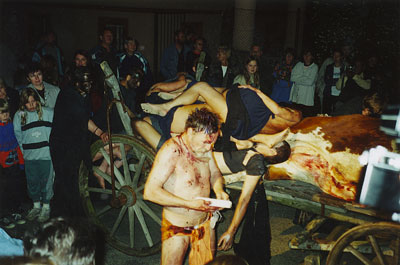 In this way, Kristek forced the spectator to think about the extent to which this boundary is clearly defined and whether it exists at all. Similarly, when he was born from a cow to present his manifest in the happening Pyramidae – Klipteon II or Mythological Landscape No. 2002, the spectators had to face the dead cow in a new context (not on a plate during lunch, but in an artistic action). The point is not to understand the situation, but to experience it... and than to reflect it. Through the evoking of a threshold situation, liminality which deviates from the known standards, he opens the path to transformation. The shocked spectator is transported to a place outside his own stereotypes and has the possibility to re-evaluate subsequently from a point of detachment. He is no more only a witness, he is "moved" and is able to reflect on the events. “That reflection is the liminal time during which the transformation of consciousness takes place.” (10)
In this way, Kristek forced the spectator to think about the extent to which this boundary is clearly defined and whether it exists at all. Similarly, when he was born from a cow to present his manifest in the happening Pyramidae – Klipteon II or Mythological Landscape No. 2002, the spectators had to face the dead cow in a new context (not on a plate during lunch, but in an artistic action). The point is not to understand the situation, but to experience it... and than to reflect it. Through the evoking of a threshold situation, liminality which deviates from the known standards, he opens the path to transformation. The shocked spectator is transported to a place outside his own stereotypes and has the possibility to re-evaluate subsequently from a point of detachment. He is no more only a witness, he is "moved" and is able to reflect on the events. “That reflection is the liminal time during which the transformation of consciousness takes place.” (10)
Sometimes it only seems that the public is passive. At Kristek’s happenings, many things are going on at once, and the event has many overlapping layers of expression and significance. In 1910, the Austrian director Max Reihnardt (1873–1943) used a similar effect in the performance Sumurun in the Berlin Deutsches Theater. Over the auditorium, he located a long, narrow bridge called a hanamichi, which is used in Japanese kabuki theatre. The action on the bridge distracted the spectator from the action on the stage, and he was forced to choose.(11) Reinhardt did this at a time when the dominant status of the text and the clear separation of the stage and auditorium were characteristic in theatre. He wanted to activate the spectator; he tried to get him to shift from the role of consumer to the role of co-creator.
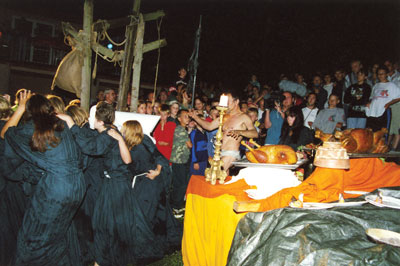 But Kristek goes even further. He is trying to evoke a specific way of perception. According to his theory, if the scenes are not organised in a linear manner, and the flow of events does not constitute a connected continuum, but on the contrary, if several different events are happening at the same time, a far more plastic, holographic picture is formed in the spectator's mind. This holographic perception has a far greater impact on the emotive, creative and intuitive elements of the personality. So, according to Kristek, the layering of scenes and meanings does not result in a disruption of the overall perception, but rather in its sharpening.
But Kristek goes even further. He is trying to evoke a specific way of perception. According to his theory, if the scenes are not organised in a linear manner, and the flow of events does not constitute a connected continuum, but on the contrary, if several different events are happening at the same time, a far more plastic, holographic picture is formed in the spectator's mind. This holographic perception has a far greater impact on the emotive, creative and intuitive elements of the personality. So, according to Kristek, the layering of scenes and meanings does not result in a disruption of the overall perception, but rather in its sharpening.
Dynamism, movement and constant change are characteristic for Kristek’s work. The ballerina or dancer, whom he frequently represents in paintings and assemblages, is also an important figure in his happenings. He is not a total stranger to ballet drill. When he was very young he spent several years going to the ballet lessons of the dancer and choreographer Ivo Váňa Psota (1908–1952) But in his happenings, Kristek attempts to get away from the entrenched structure and to go beyond the boundaries. He frees ballet from its defined framework. In many ways, his experimentation is reminiscent of the work of the American dancer and researcher Anna Halprin (born 1920), a significant representative of postmodern dance who radically overturned the existing rules. “The dancer could use every part of her or his body. We could speak, we could sing, we could create sculpture, we were total artists. And we broke the whole idea of where dances or theatre had to take place. (…) So we broke as many barriers as we possibly could.” (12)
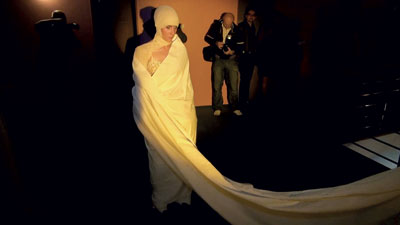 Often Kristek abstracts the lines of the dancer’s body in a manner similar to that of the American choreographer Alwin Nikolais (1910–1993), one of the first representatives of the multimedia concept of theatre and a dance experimenter. In the performance Masks, Props and Mobiles (1953), in the part Noumenon, he dressed the dancers in sacks made of flexible material. During movement their bodies formed completely new shapes. In the 4th happening, as part of the unveiling of his Glyptotheque(13), Kristek put the dancers in large bags with openings symbolising sea foam. The bag-like shape on the ground writhed in waves and changed shape, for brief moments arms appeared, but then disappeared immediately. In the happening Testimony about the Soul,(14) he wrapped bandages around a ballerina which restricted her movements. He then wrapped it all up, including the ballerina (tutu), in a long white sheet, so all the lines were deformed. In this way, he created his own, new aesthetic, which is not, however, autotelic. Kristek creates restrictions so that the characters can free themselves from them. The main thing for him is the process of “hatching” and discovery of the possibilities that the newly gained freedom brings. The restriction is thus just the starting point providing inspiration for creativity and leading to liberation.
Often Kristek abstracts the lines of the dancer’s body in a manner similar to that of the American choreographer Alwin Nikolais (1910–1993), one of the first representatives of the multimedia concept of theatre and a dance experimenter. In the performance Masks, Props and Mobiles (1953), in the part Noumenon, he dressed the dancers in sacks made of flexible material. During movement their bodies formed completely new shapes. In the 4th happening, as part of the unveiling of his Glyptotheque(13), Kristek put the dancers in large bags with openings symbolising sea foam. The bag-like shape on the ground writhed in waves and changed shape, for brief moments arms appeared, but then disappeared immediately. In the happening Testimony about the Soul,(14) he wrapped bandages around a ballerina which restricted her movements. He then wrapped it all up, including the ballerina (tutu), in a long white sheet, so all the lines were deformed. In this way, he created his own, new aesthetic, which is not, however, autotelic. Kristek creates restrictions so that the characters can free themselves from them. The main thing for him is the process of “hatching” and discovery of the possibilities that the newly gained freedom brings. The restriction is thus just the starting point providing inspiration for creativity and leading to liberation.
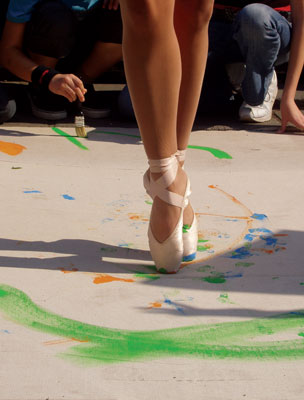 Kristek’s ballerina is not merely a tool of creation (for example a pallet or brush, as in his body-painting events), but also herself creates. In Requiem for Mobile Phones II,(15) Kristek soaked the ballerina’s pointe shoes in paint and had her dance over the painting being created. Her dance left colourful tracks, which then served as the inspiration for further creation.
Kristek’s ballerina is not merely a tool of creation (for example a pallet or brush, as in his body-painting events), but also herself creates. In Requiem for Mobile Phones II,(15) Kristek soaked the ballerina’s pointe shoes in paint and had her dance over the painting being created. Her dance left colourful tracks, which then served as the inspiration for further creation.
Another integral part of his happenings is music, which has accompanied him throughout his life. He learnt the piano as a child, and he later learned the double bass at a conservatoire. For many years, he played music (mostly jazz and soul). He has worked with composers, for example Otakar Olšaník, Miloš Štědroň and Daniel Forró, on the preparation of some happenings. And the works of classical composers have been played, for example Johann Sebastian Bach, Giuseppe Verdi, Giacomo Puccini and Pietro Mascagni, as well as Carl Orff and the experimenters Anthony Braxton and David Tudor...
Lubo Kristek’s happenings are elaborate dynamic assemblages of scenic images. They are often evocative of the work of the American avant-garde director Robert Wilson (born 1941). The complex structure can be seen in particular in the happenings Love in circulo vitioso in finito secundi milenii(16), The Gateway to the New Dimension(17) or the stage happening Space of Soul II(18).
Video: happening Love in circulo vitioso in finito secundi milenii
(20th June 1998, Landsberg am Lech)
Video: happening Space of Soul II
(10th November 2001, Hasselt)
For Kristek, it does not involve direction or choreography prepared in great detail. In the inner structure of his happenings, the space for improvisation, experiment or development of a random impulse is intentionally occupied. And so his cooperation with professional artists from the field of ballet, music and theatre is especially fruitful. Kristek has a carefully worked out “map” of the happening, which the performers fill in with their “landscapes”. This is not a mere point-by-point script, but a complex structure of internal relations, formulae and dynamic forces.
Over several decades symbols have taken form in his happenings, but they are still a work in progress. One of his quotes is characteristic of him: “I’m not interested in what I already know – I'm interested in what I don't know yet.” So in addition to the ballerina in various forms, we find, for example, a figure on huge stilts with long crutches which often represents the higher dimension or the Cosmos. This figure does not intervene directly in the action, but becomes an important intermediary, a link between worlds. Sometimes the Cosmos gives birth to another figure, such as in the happening The Gateway to the New Dimension. At other times it brings magical items (a black rose or whistle in the happening Visio sequentes or Concerning the Prematurely Cloned Age of One Planet) or a message in the form of silver crocks (in the 10th happening as part of the opening of Kristek Thaya Glyptotheque). Other figures who appear are the priest, who wants to pass on an urgent message, but no one tries to understand him, the policeman, who assigns personal licence numbers to the others, or the nuns in male form who protect the art with assault rifles. A special place in the symbolism is also held by the clown or figure of the fool, who is often the bearer of the crucial impulse for a society that goes in the wrong direction. The artist also involves live animals in the happenings, for example in The Conception with Time or Sarcophagus of Dreams(19) a goat, which after the ruin of society feeds on the last supper.
Video: happening Gateway to the New Dimension
(1st November 2012, Sychrov)
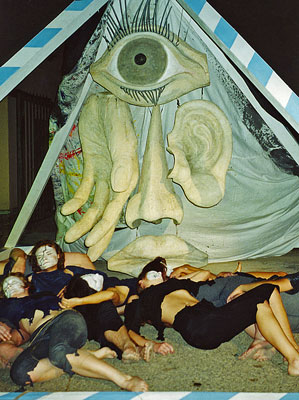
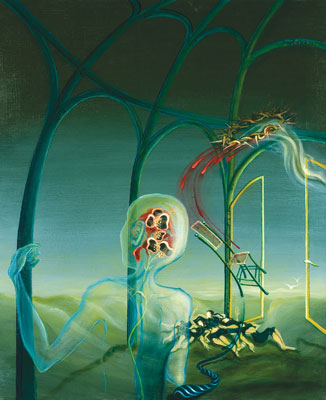 Kristek’s creative flows are interlinked. Some of the happening scenes later appeared in his paintings. For example he referenced the Podhradí happening Pyramidae – Klipteon II or Mythological Landscape No. 2002, cited above, in which Kristek was born as the last offspring from a cow symbolising a dying society, in the paintings In the Captivity of the Worldly Cathedral (2002–2003) and Latent Flight to the Seventh Dymension (2003). In the second of the paintings he also incorporated the scene of the Crucified from the happening The Conception with Time or Sarcophagus of Dreams. Some of these works of art become an inspiration for a happening, as was the case, for example, of the assemblage In the Prematurely Cloned Age of One Planet (2003), which appeared in the happening Visio sequentes or Concerning the Prematurely Cloned Age of One Planet.
Kristek’s creative flows are interlinked. Some of the happening scenes later appeared in his paintings. For example he referenced the Podhradí happening Pyramidae – Klipteon II or Mythological Landscape No. 2002, cited above, in which Kristek was born as the last offspring from a cow symbolising a dying society, in the paintings In the Captivity of the Worldly Cathedral (2002–2003) and Latent Flight to the Seventh Dymension (2003). In the second of the paintings he also incorporated the scene of the Crucified from the happening The Conception with Time or Sarcophagus of Dreams. Some of these works of art become an inspiration for a happening, as was the case, for example, of the assemblage In the Prematurely Cloned Age of One Planet (2003), which appeared in the happening Visio sequentes or Concerning the Prematurely Cloned Age of One Planet. 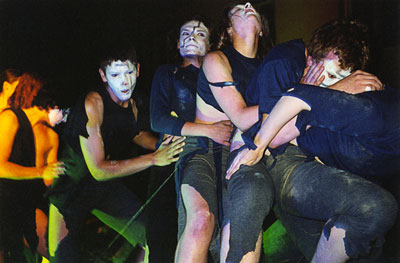
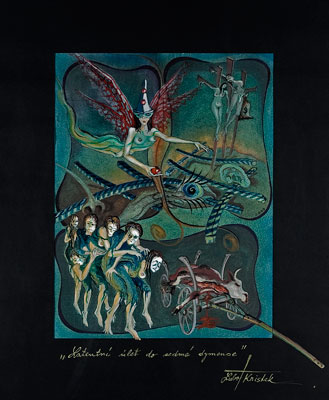
Kristek thus creates a succesively layered transmedial artwork. The works in various techniques originate one at a time. Each one of them constitutes one layer of the complex artwork. In many cases, we have to take into account Kristek’s happening, sculpture, and painting (or more) – the interconnected layers – to be able to examine the whole work of art.
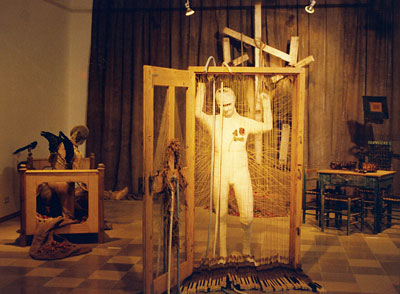 Sometimes Kristek creates works from bodies, such as in The Space of Soul in the Landsberg Neues Stadtmuseum in 1992, when he arranged a living picture made of figures around crosses. Moreover, the assemblage Door was created during this happening. In the beginning, Kristek himself hung on the cross with bandage all over his body. Then he was took down symbolically and the illusion of him stayed in the assemblage forever.
Sometimes Kristek creates works from bodies, such as in The Space of Soul in the Landsberg Neues Stadtmuseum in 1992, when he arranged a living picture made of figures around crosses. Moreover, the assemblage Door was created during this happening. In the beginning, Kristek himself hung on the cross with bandage all over his body. Then he was took down symbolically and the illusion of him stayed in the assemblage forever.
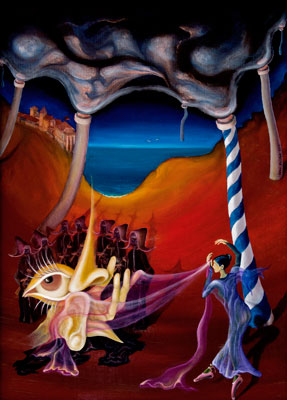 Elsewhere the works of art become “requisites” in a happening. The wooden sculpture called Pyramidae – Klipteon (1998), consisting of huge representations of the human senses, has appeared in several happenings (as well as during the opening of Kristek Thaya Glyptotheque). In the Sychrov happening, The Gateway to the New Dimension, the eye (part of the sculpture) became a symbol of the further dimension. The artist then painted this happening in the painting Landscape of Senses with Supported Clouds (2013). And so the works in the happenings come alive in time and space, and the participants become part of Kristek’s reanimated assemblage.
Elsewhere the works of art become “requisites” in a happening. The wooden sculpture called Pyramidae – Klipteon (1998), consisting of huge representations of the human senses, has appeared in several happenings (as well as during the opening of Kristek Thaya Glyptotheque). In the Sychrov happening, The Gateway to the New Dimension, the eye (part of the sculpture) became a symbol of the further dimension. The artist then painted this happening in the painting Landscape of Senses with Supported Clouds (2013). And so the works in the happenings come alive in time and space, and the participants become part of Kristek’s reanimated assemblage.
Kristek’s work with the actor were like a development of the biomechanics of the Russian avant-garde director Vsevolod Emilevich Meyerhold (1874–1940), according to whose concept precisely considered movements should become the source of emotion. In the preparatory process, Kristek assigns a specific modus of movement to many characters, a modus which the actors must adopt. But this is only a starting point from which the improvisation develops, because he intentionally creates the happenings as formally open, in a manner comparable to that of the Serbian performer Marina Abramović (born 1946) for example. In 1994, the magazine Medizin + Kunst wrote about the openness of Kristek’s happenings: “In his artistic process we can see the linkage to Freudian psychoanalysis, his happenings and performances are conducted in the spirt of the so-called ‘Activité Paranoique Critique’ of Salvador Dali, and in them the artist has the possibility to develop his uncommon abilities and go into a trancelike state – with a wholly unexpected end. (…) Yet at the same time, Lubo Kristek looks for the opening of new spaces, he attempts to vibrate the unknown places of the spectators’ soul, and the intention of his performance is the force of creation and artistic intuition even to overcome death mentally.” (20)
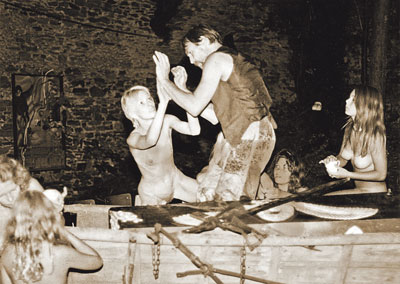 Kristek himself appears in many happenings. In this way, he attempts to disrupt the traditional relationship between the object and the subject where the work is separated from its creator, because through involvement in a happening he becomes to a significant extent the work itself. And yet he has the opportunity to intervene in events at any time, to inject an unexpected impulse and reinforce the authenticity of the action. And so paradoxically, the artist who creates the structure of the happening becomes an anti-structural element. He often intentionally causes uncertainty in the spectators, performers and himself in order to discover new, hitherto dormant sources. In his happenings he does not present reality, but creates it. With his happenings, Kristek invites one on a pilgrimage to one’s own inner space, on a trip to seek out one’s own identity.
Kristek himself appears in many happenings. In this way, he attempts to disrupt the traditional relationship between the object and the subject where the work is separated from its creator, because through involvement in a happening he becomes to a significant extent the work itself. And yet he has the opportunity to intervene in events at any time, to inject an unexpected impulse and reinforce the authenticity of the action. And so paradoxically, the artist who creates the structure of the happening becomes an anti-structural element. He often intentionally causes uncertainty in the spectators, performers and himself in order to discover new, hitherto dormant sources. In his happenings he does not present reality, but creates it. With his happenings, Kristek invites one on a pilgrimage to one’s own inner space, on a trip to seek out one’s own identity.
The art and musical experience of this artist are blended in a distinct approach to art, but the approach is always open and constantly changing. Constant change is the only constant in Kristek’s way of working. He intentionally puts distance between himself and the text in order to deepen the perception of the world as a repository of experiences. He intentionally does not follow any of the representatives of performance arts or happenings; his point of departure is himself and the endless range of impulses which surround him. “His art makes demands. And because he is also a spectator of his own art, he first makes demands on himself: and so in the person of Lubo Kristek it draws back the bolt, and opens the floodgates and the locked door; he becomes the explorer of caves and probes his own depths and those of his surroundings. Depths from which the artist Lubo Kristek can then gain ideas.” (21)
In the years 2005–2006, Lubo Kristek created an art-philosophical pilgrims’ way that bears his name. He decided to open it symbolically with a series of happenings, which started at the source of the Moravian Thaya and continued downstream. Through the creation of a place of pilgrimage with a dominant sculptural feature, each of the stations gained a new function. This transformation culminated during Kristek’s happenings, for which the Czech composer resident in Japan Daniel Forró (born 1958) wrote the music.
The stations are selected so that each has a different character, which the individual happenings correspond to. The flows of scenes and pictures do not follow on directly one from the other, and yet a “red thread” runs through them. In each one of them, the character of the Thaya appears, sometimes concretely, sometimes as an abstract. The little girl Thaya is born at the source and ages with each happening.
For many spectators, this opening was also a pilgrimage. They followed Kristek with the performers, with them they passed through a world of fantasy and opened Kristek Thaya Glyptotheque.
Text: Iveta K. Pavlovičová
Stations: 11th Station – Secret Place


